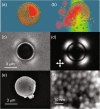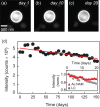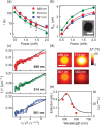Plasmon-actuated nano-assembled microshells
- PMID: 29259223
- PMCID: PMC5736557
- DOI: 10.1038/s41598-017-17691-6
Plasmon-actuated nano-assembled microshells
Abstract
We present three-dimensional microshells formed by self-assembly of densely-packed 5 nm gold nanoparticles (AuNPs). Surface functionalization of the AuNPs with custom-designed mesogenic molecules drives the formation of a stable and rigid shell wall, and these unique structures allow encapsulation of cargo that can be contained, virtually leakage-free, over several months. Further, by leveraging the plasmonic response of AuNPs, we can rupture the microshells using optical excitation with ultralow power (<2 mW), controllably and rapidly releasing the encapsulated contents in less than 5 s. The optimal AuNP packing in the wall, moderated by the custom ligands and verified using small angle x-ray spectroscopy, allows us to calculate the heat released in this process, and to simulate the temperature increase originating from the photothermal heating, with great accuracy. Atypically, we find the local heating does not cause a rise of more than 50 °C, which addresses a major shortcoming in plasmon actuated cargo delivery systems. This combination of spectral selectivity, low power requirements, low heat production, and fast release times, along with the versatility in terms of identity of the enclosed cargo, makes these hierarchical microshells suitable for wide-ranging applications, including biological ones.
Conflict of interest statement
Methods and their use of nano-assembled microshells are the subject of patents and patent applications by the University of California Merced.
Figures




References
-
- Schein P, O’Dell D, Erickson D. Orthogonal nanoparticle size, polydispersity, and stability characterization with near-field optical trapping and light scattering. ACS Photonics. 2017;4:106–113. doi: 10.1021/acsphotonics.6b00628. - DOI
Publication types
Grants and funding
LinkOut - more resources
Full Text Sources
Other Literature Sources

